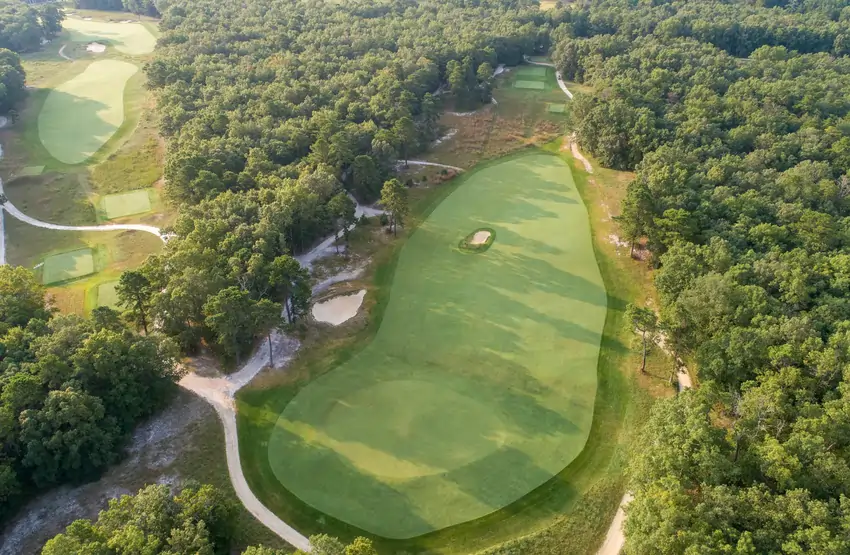The Sandbox
Sand Valley's 19-hole par-3 course, designed by Coore & Crenshaw and shaped predominantly by Jim Craig, is a masterclass in green-building

Nekoosa, Wisconsin, USA
Coore & Crenshaw (original design, 2018)
Public
$
17×3: The Sandbox
When the Sand Valley resort’s first golf course opened in the spring of 2017, owners Michael and Chris Keiser—sons of Bandon Dunes founder Mike Keiser—had already forged ahead with their next projects on the sandy, rolling Wisconsin property. By the end of the summer, two new courses had been grassed in: David McLay Kidd’s Mammoth Dunes and Coore & Crenshaw’s Sandbox. The two designs are a study in contrasts: whereas Mammoth Dunes’ 18 regulation holes sprawl over 500 acres of spectacular ridges and valleys, the Sandbox’s 17 par 3s occupy a parcel of 25 acres so flat that the Keisers had previously considered making it a driving range. In 2018, the debut year of both courses, Mammoth Dunes received more attention and accolades from the press, but over time the Sandbox has grown in stature, and many now consider it the best course at the resort.
{{content-block-course-profile-the-sandbox-001}}
Take Note…
Coore & Crenshaw & Craig. While the Sandbox is a Coore & Crenshaw design, and one where both Bill Coore and Ben Crenshaw spent a great deal of time, everyone involved with the project is quick to acknowledge associate Jim Craig’s critical role in not only the construction phase but also the design of the course. It was Craig who came up with the Sandbox’s initial routing (Coore provided edits) and who spent the most hours on site, often working literally into the night.
Why 17? At the outset of the Sandbox project, the Keiser brothers had one request: that the course have neither nine nor 18 holes. Any other number would be acceptable. In the end, Craig and Coore’s routing, which describes a lopsided, squiggly figure-eight across the property, simply worked best with 17 holes.
Peek-a-boo. Coore & Crenshaw excel at creating meaningful sightlines across their courses. From high-traffic areas—tees, landing areas, greens—you can almost always look at something interesting, whether a vista or another hole. Next time you find yourself on the first tee at the Sandbox, count the greens you can see. The number will be 12 or 13—not because there are no trees on the property, but because Coore & Crenshaw created a series of alleyways that offer glimpses of the holes ahead.
Favorite Stretch
Nos. 1-3, par 3s, various yardages
Let’s be honest: I could have randomly picked any three-hole stretch at the Sandbox and called it my favorite without really lying. The design is that good and that consistent. The opening trio, however, is especially notable for its variety and for how it introduces the course’s main themes and archetypes.
Favorite Stretch
Nos. 1-3, par 3s, various yardages
Let’s be honest: I could have randomly picked any three-hole stretch at the Sandbox and called it my favorite without really lying. The design is that good and that consistent. The opening trio, however, is especially notable for its variety and for how it introduces the course’s main themes and archetypes.
The opener is one of the Sandbox’s best ace opportunities. All contours feed into the punchbowl green, so you can use anything from a wedge to a putter off the tee. The hole is not a complete pushover, though, as a knob in the middle of the putting surface differentiates truly excellent shots from merely good ones.
In contrast with the lighthearted first, No. 2 wouldn’t feel out of place as a par 3 on one of Sand Valley’s regulation courses. It demands a full wedge or short iron to a narrow, two-tiered green benched sideways into an artificial dune. Pins on the back shelf are especially tough to attack, but front locations, surrounded by runoffs and bunkers, are plenty challenging as well.
The third hole is the shortest of the first three but has by far the largest green, a dazzling creation with twin plateaus in the back—“matchboxes,” Coore calls them—juxtaposed with swales in the front. Each pin position is a delight in its own way. (Pedantic note: the design team said this green was inspired by C.B. Macdonald’s “Double Plateau” concept, but the arrangement of the contours has more in common with the “Maiden” template frequently used by Macdonald’s protégé Seth Raynor.)
This opening sequence demonstrates the range of looks and feels Coore & Crenshaw found within the short-course framework: easy, hard, subtle, bold, tiny, huge, conventional, bizarre.

{{content-block-course-profile-the-sandbox-002}}
Overall Thoughts
There is not a single short course in Golf Digest’s, Golf Magazine’s, or Golfweek’s rankings of the top 100 (or 200) golf courses in America. Why is that?
In the literary world, short stories struggled for a long time to garner esteem from critics, or even from authors themselves. The novel was seen as more serious and noble, a truer examination of a writer’s talent. From the late 1800s through the late 1900s, however, writing short stories for newspapers and magazines offered a decent living—certainly a more stable one than toiling away on big books that might not sell. So F. Scott Fitzgerald, for example, churned out his casually brilliant short stories with something close to self-hatred. He would have preferred to focus on writing novels like The Great Gatsby, but he had to support his and his wife’s globe-trotting lifestyle. Dashing off ditties like “Bernice Bobs Her Hair” for the Saturday Evening Post kept the party going.
Yet there was never any particular reason to look down on short stories and those who wrote them. That’s just how it was.
Over the past few decades, though, critical regard for short stories has been on the rise (even as, incidentally, the financial rewards for writing them have been declining). Authors who concentrated on and excelled at the form—such as Jorge Luis Borges, Flannery O’Connor, Shirley Jackson, Raymond Carver, and Alice Munro—have received new attention and respect. The short story is no longer considered inferior to the novel, just a different genre, one with its own integrity and appeal. Great short-story writers are now understood to have a particular skill set. They are masters of concision and implication; they may not construct portraits of entire societies like Tolstoy or Dickens, but their sentences hit uniquely quick and hard. They don’t waste a word.
Short courses, similarly, make specific demands on a golf architect’s craft: they reveal who can build truly compelling greens. On regulation designs, most holes—the par 4s and 5s—have plenty of space and time to develop interest. From tee to fairway to green, any number of components can stand out and make a hole feel distinctive. On a par-3 course, the greens have to be good. This is why short courses provide such an intense, revealing test of a designer’s ability.
With the Sandbox, Coore & Crenshaw, along with lead associate Jim Craig, make a strong argument that they are the best green builders of the modern era. They deliver 17 consecutive par 3s that any halfway-attentive golfer can recall individually after one round.
Coore & Crenshaw achieve this by mixing in traditional templates at regular intervals—a Maiden (No. 3), a Road green (No. 5), a Biarritz (No. 8), a Lion’s Mouth (No. 13), an Alps (No. 14), and a Redan (No. 16). The familiarity of these greens acts as a mnemonic device; it gives the player’s memory something to latch onto. But since a full-fledged template course would have been forgettable in its own way, Coore & Crenshaw devote the rest of the Sandbox to sui generis creations like the bumpy ramp of the fourth, the graceful staircase of the seventh, and the tumultuous expanse of the ninth. Each green is immediately and obviously different from the others, and each poses a fresh set of questions and challenges.
{{content-block-course-profile-the-sandbox-003}}
Most of the best-known short courses occupy more dramatic properties than the Sandbox does. Coore & Crenshaw’s own Bandon Preserve exists precisely because of the severity of its site: developer Mike Keiser felt obligated to put something in the beautiful, abrupt dunes west of the first fairway at Bandon Trails. He settled on a 13-hole par-3 course because regulation-size holes would have required too much bulldozing. A similar rationale led to the construction of McVeigh’s Gauntlet at Silvies Valley Ranch, which leaps from peak to peak across the most extreme topography I’ve ever walked with golf clubs on my back. In these cases, the short-course form gave architects the freedom to explore land that would have been inaccessible to conventional golf.
The Sandbox has a different purpose. Its nearly featureless property could have been used in many other ways—for a driving range, a putting course, or additional lodging. Instead, it became a canvas for skillful, imaginative green design. In this way, the Sandbox is purely about the art and joy of golf architecture. It deserves recognition as a great golf course, not just as a fun short course. -GM
3 Eggs
It’s hard to imagine how the Sandbox could be improved. The figure-eight routing, the green designs, the shaping, the turf presentation—every element is impeccably executed. Granted, the land is undistinguished, but Coore & Crenshaw’s artificial topography, as well disguised as we’ve come to expect from the firm, gives the site variety and a continual, well-proportioned roll. Where do you take away an Egg?
Additional Content
Course Tour

{{content-block-course-profile-the-sandbox-004}}
Leave a comment or start a discussion
Get full access to exclusive benefits from Fried Egg Golf
- Member-only content
- Community discussions forums
- Member-only experiences and early access to events
















Leave a comment or start a discussion
Lorem ipsum dolor sit amet, consectetur adipiscing elit. Suspendisse varius enim in eros elementum tristique. Duis cursus, mi quis viverra ornare, eros dolor interdum nulla, ut commodo diam libero vitae erat. Aenean faucibus nibh et justo cursus id rutrum lorem imperdiet. Nunc ut sem vitae risus tristique posuere. uis cursus, mi quis viverra ornare, eros dolor interdum nulla, ut commodo diam libero vitae erat. Aenean faucibus nibh et justo cursus id rutrum lorem imperdiet. Nunc ut sem vitae risus tristique posuere.